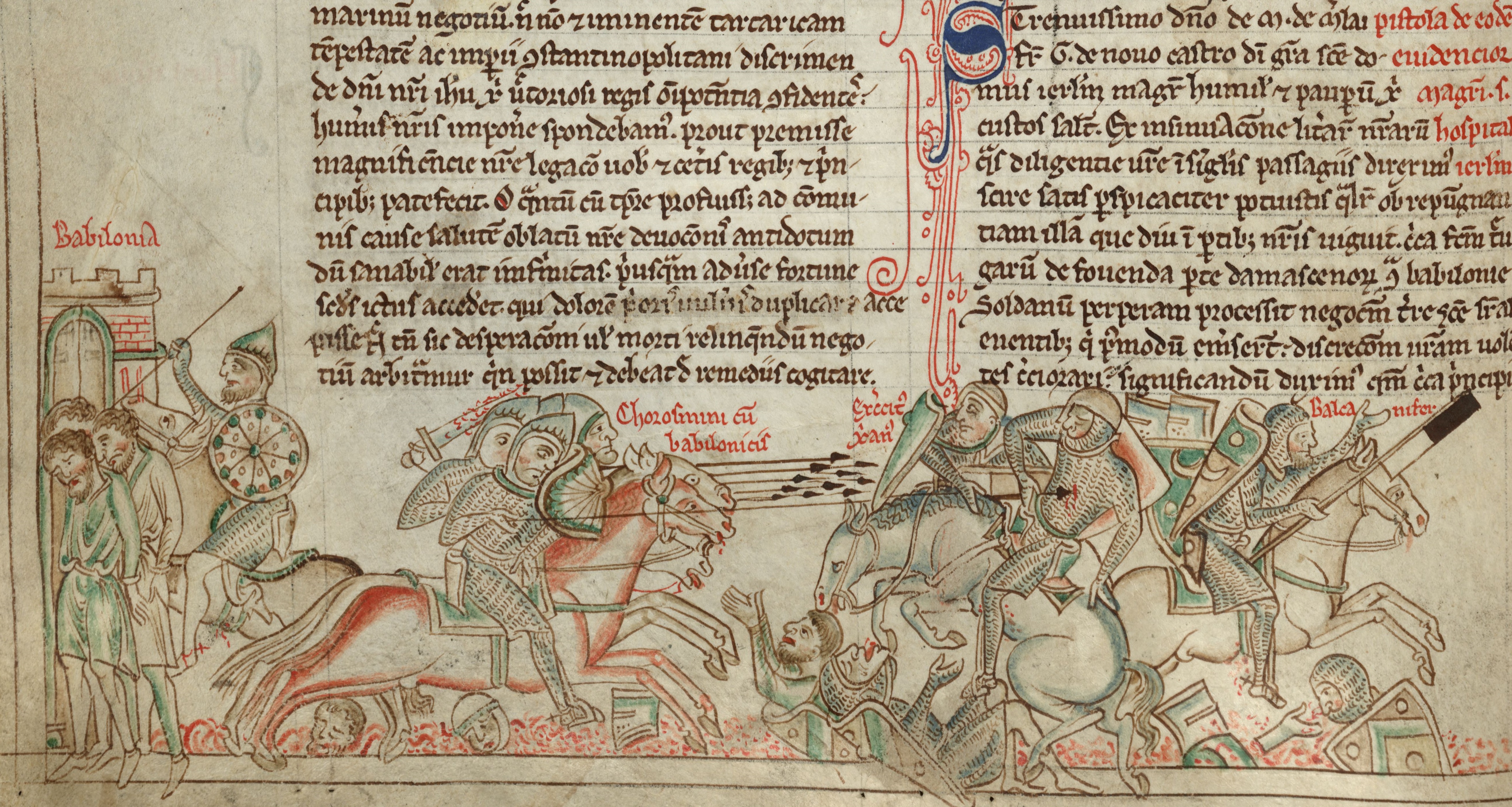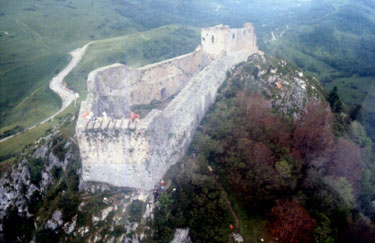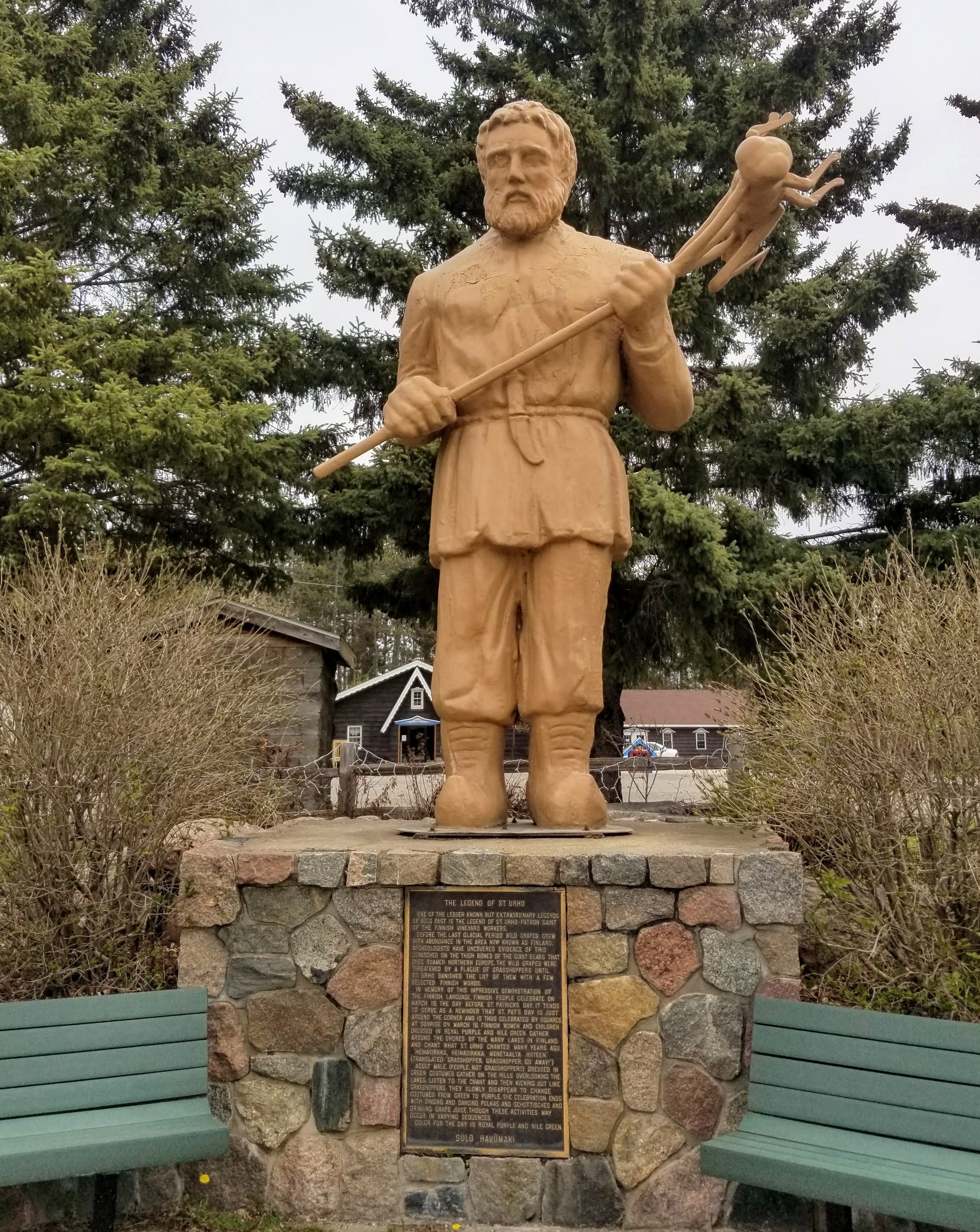|
1244
Year 1244 ( MCCXLIV) was a leap year starting on Friday (link will display the full calendar) of the Julian calendar. Events By place Europe * March 16 – Siege of Montségur: French forces capture and destroy Château de Montségur in Languedoc, after a 9-month siege. Some 200 'heretics' (''perfecti'' and ''credentes'') are burnt in a bonfire, near the foot of the castle. This marks the final defeat of the Cathars (or Albigensians); the followers become scattered fugitives, meeting in forests and mountain wilds. * March 26 – Treaty of Almizra: King James I (the Conqueror) and King Ferdinand III (the Saint) agree on the distribution of Muslim lands yet to be conquered. All lands south of a line, from the cities of Biar to Villajoyosa through Busot, are reserved for the Crown of Castile. This ends further Aragonese expansion on the Iberian Peninsula. * December – King Louis IX (the Saint) falls desperately ill of a severe malarian infection. Near-death, ... [...More Info...] [...Related Items...] OR: [Wikipedia] [Google] [Baidu] |
Khwarazmian Army Between 1231 And 1246
The Khwarazmian army, also called the ''Khwarazmiyya'', maintained itself as a force of freebooters and mercenaries between 1231 and 1246, following the Mongol conquest of the Khwarazmian Empire, Mongol conquest of the Khwarazmian Empire (1221) and the death of the last ''Khwarazmshah'', Jalal al-Din Mangburni, Jalal al-Din (1231). It was active in Upper Mesopotamia, Anatolia, Syria (region), Syria and Palestine and shifted its allegiance several times, often acting autonomously before it was defeated and destroyed by the Ayyubids. In 1231, the Khwarazmians were briefly in the service of the Ayyubid governors around Lake Van. Between 1231 and 1237, they were in the service of the Sultanate of Rum, Seljukid sultanate of Rum and fought against an Ayyubid invasion in 1232–1233. The Khwarazmians were forced back into Upper Mesopotamia in 1237, during a Seljukid succession crisis. They were then hired by the Ayyubid emir of Damascus. Taking part in the Ayyubid civil wars in Syria, t ... [...More Info...] [...Related Items...] OR: [Wikipedia] [Google] [Baidu] |
Siege Of Montségur
The siege of Montségur was a nine-month siege of the Cathar-held Château de Montségur by French royal forces starting in May 1243. After the castle surrendered, about 210 and unrepentant were burned in a bonfire on 16 March 1244. Background Although the Albigensian Crusade had been concluded with the Treaty of Paris-Meaux in 1229, local resistance continued. The Cathar Church was still able to operate and oppose the Inquisition that pervaded the Languedoc. In 1233, the Cathar Bishop Guilhabert de Castres asked Raymond de Pereille for permission to make Montségur "the seat and head" () of the Cathar Church. As a haven for Cathars, Montségur gained symbolic and strategic importance in the resistance fight against the Catholic Church and the French forces in subsequent years. In 1241, Raymond VII made a token attempt to capture Montségur, primarily to impress the King and the Catholic Church of his allegiance. At that time Montségur housed about 500 people. In the ... [...More Info...] [...Related Items...] OR: [Wikipedia] [Google] [Baidu] |
Jerusalem
Jerusalem (; he, יְרוּשָׁלַיִם ; ar, القُدس ) (combining the Biblical and common usage Arabic names); grc, Ἱερουσαλήμ/Ἰεροσόλυμα, Hierousalḗm/Hierosóluma; hy, Երուսաղեմ, Erusałēm. is a city in Western Asia. Situated on a plateau in the Judaean Mountains between the Mediterranean Sea, Mediterranean and the Dead Sea, it is one of the List of oldest continuously inhabited cities, oldest cities in the world and is considered to be a holy city for the three major Abrahamic religions: Judaism, Christianity, and Islam. Both Israelis and Palestinians claim Jerusalem as their Capital city, capital, as Israel maintains its primary governmental institutions there and the State of Palestine ultimately foresees it as its seat of power. Because of this dispute, Status of Jerusalem, neither claim is widely recognized internationally. Throughout History of Jerusalem, its long history, Jerusalem has been destroyed at least twice, Sie ... [...More Info...] [...Related Items...] OR: [Wikipedia] [Google] [Baidu] |
Ferdinand III Of Castile
Ferdinand III ( es, Fernando, link=no; 1199/120130 May 1252), called the Saint (''el Santo''), was King of Castile from 1217 and King of León from 1230 as well as King of Galicia from 1231. He was the son of Alfonso IX of León and Berenguela of Castile. Through his second marriage he was also Count of Aumale. Ferdinand III was one of the most successful kings of Castile, securing not only the permanent union of the crowns of Castile and León, but also masterminding the most expansive southward territorial expansion campaign yet in the Guadalquivir Valley, in which Islamic rule was in disarray in the wake of the decline of the Almohad presence in the Iberian Peninsula. By military and diplomatic efforts, Ferdinand greatly expanded the dominions of Castile by annexing the Guadalquivir river valley in the south of the Iberian Peninsula, establishing the boundaries of the Castilian state for the next two centuries. New territories included important cities such as Baeza, Úbeda, ... [...More Info...] [...Related Items...] OR: [Wikipedia] [Google] [Baidu] |
James I Of Aragon
James I the Conqueror ( es, Jaime el Conquistador, ca, Jaume el Conqueridor; 2 February 1208 – 27 July 1276) was King of Aragon and Lord of Montpellier from 1213 to 1276; King of Majorca from 1231 to 1276; and Valencia from 1238 to 1276 and Count of Barcelona. His long reign—the longest of any Iberian monarch—saw the expansion of the Crown of Aragon in three directions: Languedoc to the north, the Balearic Islands to the southeast, and Valencia to the south. By a treaty with Louis IX of France, he achieved the renunciation of any possible claim of French suzerainty over the County of Barcelona and the other Catalan counties, while he renounced northward expansion and taking back the once Catalan territories in Occitania and vassal counties loyal to the County of Barcelona, lands that were lost by his father Peter II of Aragon in the Battle of Muret during the Albigensian Crusade and annexed by the Kingdom of France, and then decided to turn south. His great part i ... [...More Info...] [...Related Items...] OR: [Wikipedia] [Google] [Baidu] |
Louis IX Of France
Louis IX (25 April 1214 – 25 August 1270), commonly known as Saint Louis or Louis the Saint, was King of France from 1226 to 1270, and the most illustrious of the Direct Capetians. He was crowned in Reims at the age of 12, following the death of his father Louis VIII Louis VIII (5 September 1187 – 8 November 1226), nicknamed The Lion (french: Le Lion), was King of France from 1223 to 1226. As prince, he invaded England on 21 May 1216 and was excommunicated by a papal legate on 29 May 1216. On 2 June 1216 .... His mother, Blanche of Castile, ruled the kingdom as regent until he reached maturity, and then remained his valued adviser until her death. During Louis' childhood, Blanche dealt with the opposition of rebellious vassals and secured Capetian success in the Albigensian Crusade, which had started 20 years earlier. As an adult, Louis IX faced recurring conflicts with some of his realm's most powerful nobles, such as Hugh X of Lusignan and Peter of Dreux. Simult ... [...More Info...] [...Related Items...] OR: [Wikipedia] [Google] [Baidu] |
Treaty Of Almizra
The Treaty of Almizra (or Treaty of Almiçra) was the third of a series of three treaties between the Crown of Aragon and Crown of Castile meant to determine the limits of their expansion into Andalusia so as to prevent squabbling between the Christian princes. Specifically, it defined the borders of the Kingdom of Valencia. James I of Aragon signed it on 26 March 1244, but Alfonso X of Castile did not affirm it until much later. According to the treaty, all lands south of a line from Biar to Villajoyosa through Busot were reserved for Castile. This ended most further Aragonese expansion on the Iberian peninsula. The treaty succeeded those of Tudilén and Cazorla, which were constantly breached. The clause by which neither party seemed capable of residing was that neither crown should diminish the partition assigned to the other or put any obstacle in the way of the other attaining unto his portion. That clause was broken when James I conquered Caudete, Villena, and Sax, which te ... [...More Info...] [...Related Items...] OR: [Wikipedia] [Google] [Baidu] |
Catharism
Catharism (; from the grc, καθαροί, katharoi, "the pure ones") was a Christian dualist or Gnostic movement between the 12th and 14th centuries which thrived in Southern Europe, particularly in northern Italy and southern France. Followers were described as Cathars and referred to themselves as Good Christians; in modern times, they are mainly remembered for a prolonged period of religious persecution by the Catholic Church, which did not recognize their unorthodox Christianity. Catharism emerged in Western Europe in the Languedoc region of southern France in the 11th century. Adherents were sometimes referred to as Albigensians, after the French city Albi where the movement first took hold. Catharism was initially taught by ascetic leaders who set few guidelines, leading some Catharist practices and beliefs to vary by region and over time. The movement was greatly influenced by the Bogomils of the First Bulgarian Empire, and may have originated in the Byzantine Empire, ... [...More Info...] [...Related Items...] OR: [Wikipedia] [Google] [Baidu] |
Château De Montségur
The Château de Montségur (English: Castle of Montsegur; Languedocien dialect, Languedocien: ) is a former fortress near Montségur, a Commune in France, commune in the Ariège (department), Ariège Departments of France, department in southern France. Its ruins are the site of a razed stronghold of the Cathars. The present fortress on the site, though described as one of the "Cathar castles," is actually of a later period. It has been listed as a by the French Ministry of Culture since 1862. Geography The ruins of Montségur are perched at a precarious altitude in the south of France near the Pyrenees. Located in the heart of France's Languedoc-Occitania (administrative region), Occitanie regions, southwest of Carcassonne, Montségur dominates a rock formation known as a ''pog'' — a term derived from the Languedocien dialect of Occitan language, Occitan — wikt:podium#Descendants, ''puòg'' or ''puèg'', meaning "peak, hill, mountain." The top of the ruin is reached by a ... [...More Info...] [...Related Items...] OR: [Wikipedia] [Google] [Baidu] |
March 16
Events Pre-1600 * 934 – Meng Zhixiang declares himself emperor and establishes Later Shu as a new state independent of Later Tang. *1190 – Massacre of Jews at Clifford's Tower, York. * 1244 – Over 200 Cathars who refuse to recant are burnt to death after the Fall of Montségur. 1601–1900 * 1621 – Samoset, a Mohegan, visits the settlers of Plymouth Colony and greets them, "Welcome, Englishmen! My name is Samoset." *1660 – The Long Parliament of England is dissolved so as to prepare for the new Convention Parliament. * 1792 – King Gustav III of Sweden is shot; he dies on March 29. * 1802 – The Army Corps of Engineers is established to found and operate the United States Military Academy at West Point. *1815 – Prince Willem proclaims himself King of the United Kingdom of the Netherlands, the first constitutional monarch in the Netherlands. * 1872 – The Wanderers F.C. win the first FA Cup, the oldest football co ... [...More Info...] [...Related Items...] OR: [Wikipedia] [Google] [Baidu] |
Nablus
Nablus ( ; ar, نابلس, Nābulus ; he, שכם, Šəḵem, ISO 259-3: ; Samaritan Hebrew: , romanized: ; el, Νεάπολις, Νeápolis) is a Palestinian city in the West Bank, located approximately north of Jerusalem, with a population of 126,132.PCBS02007 Locality Population Statistics. Palestinian Central Bureau of Statistics (PCBS). Located between Mount Ebal and Mount Gerizim, it is the capital of the Nablus Governorate and a commercial and cultural centre of the State of Palestine, home to An-Najah National University, one of the largest Palestinian institutions of higher learning, and the Palestine Stock Exchange.Amahl Bishara, ‘Weapons, Passports and News: Palestinian Perceptions of U.S. Power as a Mediator of War,’ in John D. Kelly, Beatrice Jauregui, Sean T. Mitchell, Jeremy Walton (eds.''Anthropology and Global Counterinsurgency,''pp.125-136 p.126. Nablus is under the administration of the Palestinian National Authority as part of Area A of the West Ba ... [...More Info...] [...Related Items...] OR: [Wikipedia] [Google] [Baidu] |
Tiberias
Tiberias ( ; he, טְבֶרְיָה, ; ar, طبريا, Ṭabariyyā) is an Israeli city on the western shore of the Sea of Galilee. A major Jewish center during Late Antiquity, it has been considered since the 16th century one of Judaism's Four Holy Cities, along with Jerusalem, Hebron, and Safed. In , it had a population of . Tiberias was founded circa 20 CE by Herod Antipas and was named after Roman emperor Tiberius. It became a major political and religious hub of the Jews in the Land of Israel after the destruction of Jerusalem and the desolation of Judea during the Jewish–Roman wars. From the time of the second through the tenth centuries CE, Tiberias was the largest Jewish city in the Galilee, and much of the Mishna and the Jerusalem Talmud were compiled there. Tiberias flourished during the early Islamic period, when it served as the capital of Jund al-Urdunn and became a multi-cultural trading center.Hirschfeld, Y. (2007). Post-Roman Tiberias: between East and We ... [...More Info...] [...Related Items...] OR: [Wikipedia] [Google] [Baidu] |










.jpg)